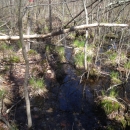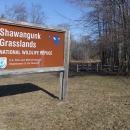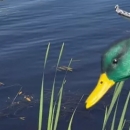About Us
Cherry Valley National Wildlife Refuge was established in December 2008 for the conservation of migratory birds and federal trust species, and the habitats they depend on. The lands and waters of the Cherry Valley have been widely recognized for their valuable natural resources. These include a diverse mosaic of wetland and upland habitats that support an unusually large number of federal trust species, including five federally listed threatened or endangered species. The Kittatinny Ridge (which flanks the south side of the valley) has been designated an Important Bird Area by the Pennsylvania Audubon Society, and is a well-known migration flyway that concentrates up to 20,000 migrating raptors and more than 140 bird species every fall. Large blocks of unfragmented forest along the ridge also serve as valuable breeding areas for interior-forest birds.
Our Mission
Cherry Valley National Wildlife Refuge (NWR, refuge) was officially established in 2010 with the purchase of the first tract of refuge land and is located in Monroe and Northampton Counties in Pennsylvania. The refuge has an active acquisition program within the 20,466-acre acquisition boundary, and currently stands at 5,471 total acres. Cherry Valley NWR is managed as part of the Lenape NWR Complex. Other refuges in the Lenape Complex include: Wallkill River NWR, Great Swamp NWR, Shawangunk Grasslands NWR, and Great Thicket NWR. The Refuge Complex headquarters is located in Sussex, New Jersey.
The refuge was established pursuant to the Migratory Bird Conservation Act of 1929 (16 U.S.C. §715), the Endangered Species Act of 1973 (16 U.S.C. §1534), Emergency Wetlands Resources Act of 1986 (16 U.S.C. §39OJ(b)) and Fish and Wildlife Act of 1956 (16 U.S.C. 742f (a)(4), (b)(1)).
Refuge Purposes
Each unit of the National Wildlife Refuge System is established to serve a statutory purpose that targets the conservation of native species dependent on its lands and waters. All activities on those acres are reviewed for compatibility with this statutory purpose.
The primary purposes of Cherry Valley NWR are:
- “for use as an inviolate sanctuary, or for any other management purpose, for migratory birds.... “ 16 U.S.C. § 7J5d (Migratory Bird Conservation Act).
- “to conserve (A) fish or wildlife which are listed as endangered species or threatened species...or (B) plants...” 16 U.S.C. § 1534 (Endangered Species Act of 1973).
- “the conservation of the wetlands of the Nation in order to maintain the public benefits they provide and to help fulfill international obligations contained in various migratory bird treaties and conventions ...” 16 U.S.C. § 39OJ(b), JOO Stat. 3583 (Emergency Wetlands Resources Act of 1986).
- “for the benefit of the United States Fish and Wildlife Service, in performing its activities and services. Such acceptance may be subject to the terms of any restrictive or affirmative covenant, or condition of servitude... "16 U.S.C. § 742f(b)(J) (Fish and Wildlife Act of 1956).
Our History
Cherry Valley National Wildlife Refuge was established in December 2008 and the first property was purchased in 2010. The refuge land is part of the Lenape ancestral homelands.
Other Facilities in this Complex
The Cherry Valley National Wildlife Refuge is part of the Lenape National Wildlife Refuge Complex, which comprises four national wildlife refuges — Shawangunk Grasslands, Wallkill River, Cherry Valley, and Great Swamp — in New York, New Jersey, and Pennsylvania. Overlapping significantly with the Lenape ancestral homelands, the refuges cover a diverse area with a diverse heritage. A National Wildlife Refuge Complex is an administrative grouping of two or more refuges, wildlife management areas or other refuge conservation areas that are primarily managed from a central office location. Refuges are grouped into a complex structure because they occur in a similar ecological region, such as a watershed or specific habitat type, and have a related purpose and management needs. Typically, a project leader or complex manager oversees the general management of all refuges within the complex and refuge managers are responsible for operations at specific refuges. Supporting staff, composed of administrative, law enforcement, refuge manager, biological, fire, visitor services, and maintenance professionals, are centrally located and support all refuges within the complex.




